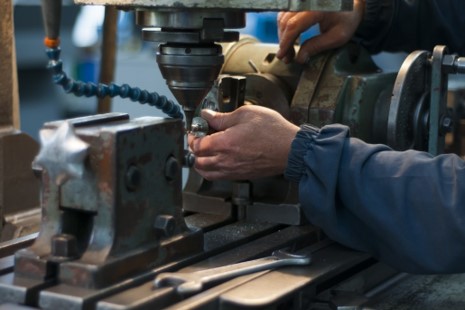When some people (of a certain generation) think of an iconic image of the American manufacturing worker, they conjure up a picture of Rosy the Riveter, that hallmark of WWII who kept US industrial production going when men of the finest generation the world has ever seen went off to defend freedom and liberty for all of mankind.
But we would like to propose that just an important an icon of American production, the machinist, deserves a seat with Rosy in the Hall of Fame of manufacturing. And no, we’re not referring to Christian Bale in the namesake psycho-thriller from 2004, but everyday machinists.
Once the backbone of the US industrial sector, these skilled workers, masters in the arts of metalworking, machine repair, and maintenance, are gradually fading from the workforce.
Machinists are trained, not educated. A machinist may not be at the top of his game after working in the field for a decade (as long as it takes to become a medical doctor including undergraduate training!) Which explains in part why this iconic profession, especially in an age where most college graduates would feel as foreign stepping foot in a local factory as a monastery in Tibet, is slowing fading into obscurity.
The decline of the machinist is leaving a vacuum that threatens the integrity of not only the traditional machine shop industries but machinery dealers as well. It’s rare to find a machinist today that is not close to retirement or already working well into their retirement years, as they can’t find anyone to replace them.

True machinists are generalists. They adapt, learn and apply their training to the job at hand — and the machines (and machine tools) available. So while there are a few newcomers ready to take their place, the younger generation entering the manufacturing world tends to have more focused skill sets on a certain machine (e.g., running a Haas Vertical Machining Center and nothing else.
The rub is specialization. Modern manufacturing education often emphasizes doing one thing perfectly, equipping students with a deep but narrow set of skills focused on specific types of machinery or technology. ‘
This contrasts sharply with the older generation of machinists, who prided themselves on a broad, robust knowledge that allowed them to operate, repair, and maintain a wide array of industrial machinery. Gone are the days where it was easy to find a machinist that knew how to run and maintain and repair all types of machines from lathes to saws to compressors.
This skills gap poses a challenge to machinery dealers, who have historically relied on the expertise of seasoned machinists to refurbish and repair machines before sale. It also allowed them to take in broken machines for trade ins and invest in them to restore and rebuild them to sell for a profit.
Many dealers are still doing this today, but if you ask them what keeps them up at night, it’s usually an answer that revolves around their machinist and how they will never be able to replace all that knowledge when they finally retire, which always seems to be a few years away…
Some dealers end up switching away from their old routines and become a broker of used or new machinery and stop taking inventory of equipment all together.
They rely on their old connections (including manufacturers) to help them acquire the machines they need to get the equipment in the hands of the manufacturer. They become in essence a concierge, a consultant if you will, to help you sift through the hundreds of machines out there and ensure you end up buying the right one for the job and at the best price.
Another problem is succession. Many dealers — whether car dealership or machinery dealerships — are family businesses in America. If there’s no one interested in running the company after one generation retires, there’s little incentive to find and replace heavily desired and costly machinists.
Make no mistake, while machinists may be considered a dying breed, they are still out there! The best way to keep this trade alive and continue passing down the baton of machine tool repair knowledge is to start an apprenticeship program — something many of the large dealers do.
It’s a heavy investment up front with little to no return until years down the line. But it’s something necessary to keep the trade alive. Because if one thing’s for sure in manufacturing, even in the year 2050, people will still want to repair their Cincinnati grinders, Bridgeport mills or manual laths they’ve been using for 40 years.
After all, they’re just getting broken in.
Written by Tommy Scanlan, Publisher, and Jason Busch, Editor at Large

